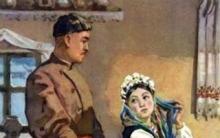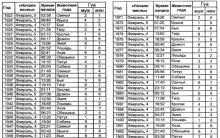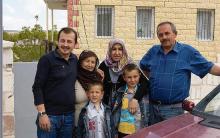Target: clarifying and consolidating ideas about the signs of Spring, identifying the simplest cause and effect relationships.
Tasks:
- activate the dictionary on the topic “Spring”;
-continue to teach how to make sentences based on pictures;
- develop observation, activity, auditory and visual attention;
- develop in children the ability to listen carefully and complement answers;
- develop the ability to work in a team.
Equipment: pictures on the theme “Spring”, tape recorder, glue, origami – snowdrops, pre-cut: sun, clouds, pencils, felt-tip pens, Whatman paper.
Preliminary work: selection of music; reading fiction on the theme of spring; individual work - learn riddles with several children.
GCD move:
Educator: Good morning! The weather is so wonderful this morning. The sun is shining outside, the birds are singing. Children, let's go to the window and look outside at how beautiful nature is.
They come to the window and admire the nature outside the window.
Educator: Guys, let's remember what time of year it is now?
Children: SPRING!
Educator: People have long loved spring. They called it spring - red, because all nature wakes up in spring. Appears green grass, first flowers, birds are flying. What birds come to us in the spring, let's remember together?
Children: rooks, starlings, larks, etc.
Educator: Let's remember together what spring months we know?
Children: March April May
Educator: That's right, guys. March is called Protalnik because the snow begins to melt and the first thawed patches form. April is a snow race, because the snow melts quickly and the streams overflow, and in some places the first green grass is already appearing. And May is Grass, because grass and young leaves on the trees appear everywhere. Listen, it's a breeze. He is still very weak. Let's help the breeze! Let's go out with you to our mat. Let's stand in a circle and say the following: magic words.
Let’s raise our right palm and blow the snowflakes off it,
We wave our left palm and invite the wind to visit.
A box appears unnoticed in the center of the carpet
Educator: Guys, look, the spring wind brought us a gift, this box. What do you think is in it? (children's answers)
Educator: Let's discover and find out together. See the map here. There are signs on it, we need to pass the tests and then we will find a surprise. Shall we go on a trip?
Children: Yes! music turns on
Educator: Here's the first task. Let's see, you won't confuse spring with winter?
Winter is gone, and spring... (came)
In winter the bear and the hedgehog sleep, and in the spring....(wake up)
Winter is cold and spring is (warm)
In winter the sun freezes, and in spring... (warms)
in winter snowing, and in the spring... (rain)
In winter they wear fur coats, and in spring (jackets).
Educator: Well done guys, you completed the first task, and now I suggest moving a little before the next task.
Physical education lesson Outdoor game “FRESHLYANKA”
Sunshine, sunshine (children walk in a circle holding hands)
Golden Bottom
Burn, burn clearly
So that it doesn't go out.
A stream ran in the garden (children run in a circle)
A hundred rooks have flown (“flying” in a circle)
And the snowdrifts are melting, melting (squat slowly)
And the flowers grow (stretch on tiptoes, hands up).
Educator: Guys, what wonderful flowers have bloomed in our group. Look at each other and smile.
Educator: Now we can move on to our next task, “Collect a picture.” You and I need to assemble three parts different pictures, and determine which spring month each picture belongs to. (independent work children)
Educator: How quickly you did it! music turns on
Let's stand in a circle in the clearing,
To solve riddles.
To answer correctly
You need to listen carefully!
Puzzles:
1. The snowball is melting,
The meadow came to life
The day is coming
When does this happen? (Spring)
And now our girls will tell us riddles:
2. A warm south wind is blowing,
The sun is shining brighter.
The snow is thinning, softening, melting,
The loud rook flies in.
What month? Who will know?
Children: March!
3. The river roars furiously
And breaks the ice.
The starling returned to his house,
And in the forest the bear woke up.
A lark trills in the sky.
Who came to us?
Children: April!
4. The distance of the fields is turning green,
The nightingale sings,
The garden is dressed in white,
The bees are the first to fly.
Thunder rumbles. Guess,
What month is this?
Children: May!
Educator: Children, look at this picture, what can you tell from it? (Children's answers)
Educator: now let's try to compose full story according to the picture. ( children answer with the help of an adult; you can listen to several stories and choose the most interesting)
Educator: Well done boys. And now we come to our last task. You and I need to compose a “Portrait of Spring”. On a sheet of whatman paper we will depict a spring meadow; for this we use colored pencils, felt-tip pens and our flowers.
(On a sheet of whatman paper, using previously cut out flowers, cloud, sun).
Educator: What a wonderful clearing we have created, let’s admire it.
Educator: and now we will repeat with you how many spring months you know (3). Which? (March, April and May)
Educator: What warms, shines, bakes in spring?
Children: Sun
Educator: What runs, murmurs, sings in the spring?
Children: trickle
Educator: What is the name of the piece of land where the snow has melted?
Children: thawed patch
Educator: Well done guys, you completed all the tasks and got to our surprise, and here is our magic box! What's inside? (there are flowers or other stickers inside)
Educator: Let everyone take a sticker and put it in their palm. Close your eyes and make your wish.
Educator: Guys, tell me, did you like our trip today? What do you remember most? (children's answers)
Educator: Our journey has come to an end. See you again!
Educator
Goals: to consolidate children’s knowledge about the season “spring”, to continue to introduce children to unconventional technology plasticine images.
1. Educational:
Strengthen the ability to identify signs of spring;
Activate the subject dictionary on the topic “spring”
Strengthen children's skills in working with plasticine - rolling, flattening, smearing the material used on the base, smoothing finished surfaces
Learn to create an expressive image through the transfer of volume and color.
2.. Developmental:
Continue to develop children’s coherent speech,
Develop physical activity
Develop interest, curiosity and cognitive motivation
Develop fine motor skills of hands
3. Educational:
Cultivate interest in the world around us and the changes occurring in it;
Material:
Thick cardboard in orange, pink, yellow.
Plasticine blue, white, green.
Modeling board
Illustration depicting a snowdrop, icicle, story pictures“Spring”, ball, icicles, basin.
Preliminary work. Conversations about spring, about the first flowers, about the signs of spring. Learning riddles, poems about spring, reading fairy tales, drawing flowers, role-playing game “Journey through the spring city.”
Listening to music "Seasons".
Compilation descriptive story"spring".
Progress of the lesson:
1. Organizational moment.
Guys! Listen to the poem.
The evil blizzard has passed away,
The night became shorter than the day.
A warm wind blows from the south,
The drops fall, ringing.
The sun, warming the earth,
The ice is driving away from our river,
The snow woman is melting
And tears flow in streams!
What time of year is this poem talking about? (About spring). How did you understand this? (Children's answers: the sun warms up, the day becomes longer than the night, the snow becomes dirty, loose, begins to melt, icicles drip, birds return from warm countries... The teacher helps the children by reading the lines of the poem). Well done guys, what is the name of the first month of spring? (Children's answers). What other months will come after March? How many months are there in spring? Repeat in chorus: “March, April, May - don’t forget them!”
2. Didactic games. Puzzles.
Didactic game “What time of year?”
Objectives: to learn to correlate the description of nature in poetry or prose with certain time of the year; develop auditory attention and quick thinking.
Progress of the game: The teacher asks the question “When does this happen?” and reads a riddle about different times of the year.
1. I have quite a lot to do -
I'm a white blanket
I cover all the land, remove the ice from the river, whiten the fields, houses
My name is. (winter)
2. I open the buds into green leaves
I dress the trees, I water the crops,
There is a lot of movement, they are calling me (spring)
3. I am woven from heat, I bring warmth with you, I warm rivers,
Take a swim! I invite you.
And you all love me for it. Ya (summer)
4. I bring the harvests, I sow the fields again, I send the birds to the south,
I strip the trees.
But I don’t touch pine trees and fir trees. Me (autumn)
5. The weather is bright.
The sun rises early.
During the day it warms and bakes,
The river beckons us with coolness,
You need to go to the forest to pick berries, keep up with the strawberries,
Don't be lazy, just collect.
Answer (summer).
6. Wonderful weather
Nature smiles!
Emerald time
Happy, happy kids!
The sun is rosy,
The morning is foggy.
Answer (summer).
7.The days have become shorter,
The nights have become longer
Who's to say, who knows
When does this happen?
Answer (in the fall).
8. Loose snow
Melts in the sun
The breeze plays in the branches,
So she came to us.
Answer (spring).
Didactic game “It happens - it doesn’t happen” (with a ball)
Goals: develop memory, attention, thinking, reaction speed.
Progress of the game: The teacher says phrases and throws the ball, and the children must answer quickly.
Snow in winter... (happens) Frost in summer... (does not happen)
Icicles in the summer... (doesn't happen) drops in the summer... (doesn't happen
And now we will play a game called “Spring Words”. I will name the words, and you guess what I'm talking about.
1. Blue, clear, cloudless, pure... (sky)
2. Long, transparent, cold, sparkling... (icicle)
3. Bright, affectionate, golden, radiant... (sun)
4. Light, spring, sunny, fine... (day)
5. Warm, pleasant, light, fresh... (wind)
6. Dirty, loose, cold, melted... (snow)
7. Young, green, fresh, tender, first (grass).
How well do you know all the signs of spring? This means that you can easily guess my riddles.
Along the paths without difficulty
Melt water rushes.
Snow from the sun's rays
Turns into... (stream)
What kind of thin needles are these?
Are they turning green on the hill?
This, having barely grown up,
Reaching towards the sun... (grass)
On a forest thawed patch
A small flower has grown.
Hiding in dead wood
Little white... (snowdrop)
Nice days are not rare
Branches bask in the sun.
And, like little dots,
The branches are swollen... (buds)
Snow and ice melt in the sun,
Birds fly from the south,
And the bear has no time to sleep.
So... (spring) has come to you
3 Physical education lesson “Spring has come”
Let's show you how to reach us Spring is coming.
If the blue river woke up from sleep (hands up, stretched out to the sides)
And runs in the fields, sparkling, (jumping in place)
If the snow has melted everywhere,
And the grass in the forest is visible, (squats)
And a flock of little birds sings -
This means spring has come to us. (claps hands)
If the sun turns red
Our cheeks are red, (head tilts to left-right shoulders)
It will be even more pleasant for us -
This means spring has come to us. (claps hands)
Educator: Spring has prepared a surprise for you. Guess what it is?
Hanging outside the window
The bag is icy.
It's full of drops
And it smells like spring
(Icicle)

That's how many icicles there are. Take one at a time.
Touch the icicle, what is it like? (Cold, wet, slippery, smooth, icy, sharp).
What is its shape? What does she look like? (For carrots).
Look at her, what is she like? (Transparent, shiny, shimmers in the sun...)
If an icicle falls, what happens? (It will break). Let's check. (I drop it). So, what is she like? (Fragile). What else breaks when you fall? (Glass).
What happens to an icicle in heat? (melts).
Take an icicle in your hand, what do you see? (Droplets flow down the icicle). Listen to the drops ringing. (Place the tray).
When a lot of icicles melt on the street at once, it turns out to be droplets.
Educator: In early spring open places, in thawed patches where the snow has melted, the first flowers appear.
The first one out of prison
On a thawed patch,
He is not afraid of frost
Even if it's small.
Children: This is a snowdrop.
Educator: in March the sun is shining, in March water flows from the roofs,
And the snowdrop bloomed on time - the first flower of March.

Educator: That's right, but do any of you know why it's called that?
Children: A snowdrop appears from under the snow; it is blooming, it is white as snow...
Educator: That's right, he starts under the snow and appears in early spring, he is not afraid of cold, frost, or strong wind. He's so seasoned!
Educator: Delicate snowdrop flowers, similar to bells, attract the attention of everyone who sees them. People collect primroses in bouquets, not thinking that in captivity they will quickly wither and will not live long. Therefore, in order not to destroy nature, you can photograph flowers, draw or make a stucco picture with their image. And we will do this with you now.
4. Practical part:
Looking at an illustration of a snowdrop, highlighting the parts (stem, leaves, flower)
Stems: Roll thin long sausages from green plasticine and secure them to the base.
Leaves: Roll into a thin green sausage, flatten with your fingers, sharpen on both sides, then place the leaves near the stem, flatten, secure to the base.
Snowdrop petals: roll into a sausage white, sharpen at the ends, like leaves. Arrange a flower from the prepared petals. Draw other snowdrops in the same way.
Warm-up for fingers: “Palms”
Here's our game
Clap one hand, clap another
Right left palm
We'll clap a little
And then with your left palm
You clap on the right.
And then, then, then
We'll even beat your cheeks.
Palms up - clap, clap, clap.
On the knees - slap, slap, slap.
Now pat me on the shoulders,
Slap yourself on the sides.
We can clap behind your back
Let's clap for ourselves!
On the right we can, on the left we can!
And let's fold our hands crosswise!
And we will stroke ourselves
What a beauty!
Children complete the task.

5. Summary of the lesson.
Guys, we named the signs of spring, guessed riddles about spring, showed how spring goes, played spring words, made a picture.
Guys, won’t you confuse winter with spring?
Let's check it now.
Winter is gone, and spring - ... - has come.
Winter is cold, and spring is... - warm.
In winter the sun freezes, and in spring - ... - warms.
In winter the snowdrifts are high, and in spring -... - low.
In winter they wear fur coats, and in spring - ... - jackets.
They answered everything correctly, well done.
That's how much we managed to do. What did you like most?
What did we do in class today?
Guys, what time of year were we talking about today? (About spring).
What spring months do you know? (March April May).
What signs of spring do you know? (In spring it becomes warmer, the sun strongly heats the earth, the first flowers and grass appear, the snow melts, birds fly from warm countries).
Guys, you completed all the tasks. Well done, everyone did a good job today.
Final complex lesson for children of the middle group: “Spring is a freckle,” which was developed by me with the aim of strengthening children’s knowledge about the signs of spring, about changes in nature with the onset of spring.
Tasks:
Clarify and generalize children’s ideas about characteristic features spring, expand children's knowledge about spring, enrich and activate vocabulary on the topic;
Repeat with the children the names of spring flowers (lily of the valley, snowdrop, tulip, daffodil, dandelion)
Develop attentiveness and observation, fine and gross motor skills, communication skills;
Exercise the ability to work collaboratively unconventional technology using cut appliqué;
Make children feel happy about the activity they have done.
Materials and equipment:
➣ Wall newspaper “Spring - little spring”;
➣ Illustrations of spring flowers (lily of the valley, snowdrop, tulip, dandelion, daffodil);
➣ Cut pictures of spring flowers;
➣ Green paper napkins (grass), yellow mugs (dandelions), glue, brushes, napkins for each child, whatman paper (glade).
Preliminary work:
✓ observations in nature;
✓ looking at paintings and illustrations about spring;
✓ solving riddles.
GCD move:
1 part: Children enter the group, sit in a semicircle, the teacher reads a poem:
Spring is coming to us
With quick steps,
And the snowdrifts melt under her feet.
Black thawed patches
Visible in the fields.
You can see very warm feet in spring. (I. Tokmakova)
V-l: Guys, what is this poem about? (about spring).
Vs: That's right, about spring.
Guys, look carefully at the picture (points to the wall newspaper “Spring - Little Spring”).
Now I will tell you riddles, you will guess them, and you will find them here.
Housewarming party at the starling's
He rejoices endlessly.
So that a mockingbird lives with us -
We made... (birdhouse)
In a blue shirt
Runs along the bottom of the ravine. (Creek)
Here on a branch is someone's house,
There are no doors in it, no windows,
But it’s warm for the chicks to live there,
This is the name of the house... (Nest)
There is crackling and thunder on the river,
This means icebreaker
There is ice on the river
This means...(Ice drift)
The carrot is white,
It grew all winter.
The sun has warmed up -
Ate all the carrots (Icicle)
He has a carrot nose
He loves frost very much
It doesn't freeze in cold weather.
And spring comes and melts. (Snowman)
The first to get out of the earth
On a thawed patch.
He is not afraid of frost
Although small (Snowdrop)
She comes with affection
And with my fairy tale.
He'll wave his magic wand,
The snowdrop will bloom in the forest (Spring)
(After each answer, the teacher asks the child: -When does this happen?)
.jpg)
V-l: Well done, you solved all the riddles. Children, who knows the proverbs about spring?
Children say proverbs:
Rook on the mountain - spring is in the yard.
Winter scares spring, but it itself melts.
Spring is red with flowers and autumn with pies
Vs: Let's play and show how spring is coming to us!
The outdoor game “Vesnyanka” is being played
Sunshine, sunshine, Children walk in a circle, holding hands. Golden bottom.
Burn, burn clearly
So that it doesn't go out.
A stream ran in the garden, They ran in a circle.
A hundred rooks have arrived and are “flying” in a circle.
And the snowdrifts are melting, melting, Slowly squatting.
And the flowers are growing. Stretch on tiptoes, arms up.
.jpg)
V-l: Guys, look! And here the flowers have grown.
(Children approach the “Spring Flowers” stand)
.jpg)
V-l: What flowers grow here?
Children take turns pointing and naming flowers.
The teacher praises the children.
Held didactic game"Collect a flower"
The teacher gives each child an envelope containing a cut-out picture.
The children lay out their flower on the carpet. Then the teacher asks each child what kind of flower he got.
.jpg)
Vs: Guys, now we will show you how flowers grow.
Finger gymnastics “Flower”
A tall flower grew in a clearing. Show a flower with your hands.
On a spring morning I opened the petals. Spread your fingers.
Beauty and nutrition to all petals Movement of fingers together and apart.
Together they grow roots underground. Palms down, back side
Towards each other, spread your fingers.
.jpg)
Vs: Guys, you guessed riddles about spring signs, showed how spring progresses, how a flower grows, remembered the names of spring flowers, collected pictures, and now I propose to depict a clearing with dandelions.
part 2: Children perform teamwork“Meadow of dandelions” using an unconventional technique - cut-out appliqué.
(audio recording “Magic sounds of nature - birdsong, sound of water, bells”).
.jpg)
.jpg)
.jpg)
Part 3: The teacher sums up the results, asks the children what they did today, what they liked most, and treats the children to an “edible meadow of flowers” made from cookies and marmalade.
Introspection.
The lesson was carried out in accordance with the notes. The abstract was compiled independently, in accordance with the objectives of the main general education program, corresponding to the given age of children. To implement each task, techniques were selected to help solve software problems in an interesting and entertaining way. For each moment, classes were selected visual aids, which stimulated and activated children to mental activity. The manuals are of sufficient size and aesthetically designed. Their placement and use was rational and well thought out in the learning space.
During the application, music was used, which enhanced the emotional perception. The duration of the lesson corresponds hygiene standards for middle-aged children - 20 minutes. Air, heat and sanitary conditions were observed.
The lesson is dynamic, it includes techniques that provide for a quick change of activity. Guessing riddles - sitting on chairs, outdoor game - moving in a circle, didactic game - sitting on a rug, finger gymnastics - standing. A quick rotation of techniques and changes in poses during the lesson made it possible to avoid fatigue in children. I believe that the program tasks set during the lesson were solved.
Objectives: 1. Educational: to consolidate children’s knowledge about the familiar works of N. Nosov; introduce children to N. Nosov’s new work “On the Hill”; learn to characterize the hero; enrich speech.
2. Developmental: develop interest in the works of N. Nosov.
3. Educating: to educate careful attitude to people's work.
Vocabulary work: janitor.
Preparatory work: reading N. Nosov’s stories “Live Hat”, “Lollipop”, “Patch”, “Entertainers”, “Cucumbers”; fairy tales “Bobik visiting Barbos”, “The Adventure of Dunno and his friends”.
Visual material: a portrait of the writer, works by N. Nosov in various editions, attributes for N. Nosov’s stories: a hat, a piece of green fabric, a lollipop, Dunno’s hat.
Progress of the lesson.
Orgmental moment: Children greet guests with a poem.
Invented by someone
Simple and wise
When meeting, say hello;
Good morning!
Good morning to the sun and birds!
Good morning to friendly faces!
Everyone becomes kind and trusting.
Good morning lasts until evening.
Guys, let's smile at each other, our guests, and let good mood does not leave us all day.
We are in the literary drawing room. Have a seat.
Look at the box I have. Let's take a look into it. (Get Dunno's hat)
Guys, what fairy tale hero does this hat belong? (Dunno).
What fairy tale is he from? (From the fairy tale “The Adventure of Dunno and His Friends.”)
Oh, look at this hat. What work is it from? ("Living Hat").
Who was sitting under this hat? (Kitten Vaska).
How did he get under the hat? (the hat fell from the chest of drawers, and a kitten was sitting near the chest of drawers).
Take out a green piece of fabric. What story is this scrap from? ("Patch")
What is a patch? (A piece of fabric is sewn onto the clothing to close the hole)
I have some candy in my box. What story is this candy from? ("Lollipop").
What happened to the hero of the story “Lollipop” when he ate the candy? (With sticky hands he took the sugar bowl and broke it.)
Look, guys, in the box there is a fairy tale “The Three Little Pigs”. Which story tells about this fairy tale? (In the story “Entertainers”). Why were the children in the story called entertainers? What they were doing? (We started a game based on the fairy tale “The Three Little Pigs”)
Guys, who wrote all these stories and fairy tales that we were talking about now?
Look at the portrait of this wonderful children's writer. Nikolai Nikolaevich Nosov loved children very much. When his son was born, he began writing stories for him and his friends.
In N. Nosov's stories, all the guys are very friendly. Are you guys friendly? Let's remember finger gymnastics"Friendly fingers."
The children get up.
Friends in our group
Girls and boys. (join hands in a “lock”).
We'll make friends with you
Little fingers. (at the same time touch the fingertips of one hand to the fingers of the other hand).
One, two, three, four, five (alternately connect fingers)
One, two, three, four, five (alternating touch).
Now I will read to you new story Nikolai Nosov “On the Hill”.
Reading a story.
What is the name of the story I just read?
What was the name of the main character of the story? (Kotka).
What was Kotka like at the beginning of the story? (lazy, cunning, bad).
What bad did he do? (ruined the slide).
And what did he become at the end of the story? (smart, hardworking).
Can you call him smart? Why? (I made steps to the side of the slide so that it would be convenient for everyone to climb).
In the story “On the Hill” the word “janitor’s” appears. What word does it come from? (from the word janitor).
The janitor's room is the room in which the janitor's tools are stored.
Guys, in the story the children were riding a slide. Let's now show you what else we like to do outside in winter.
Game "What we like in winter." (words by L. Nekrasova)
1. Educator: What do you like in winter?
Children: White Glades
And on the icy hill
Skis or sleds. (Children walk in a circle with a “sliding” step.)
2. Educator: What do you like in winter?
Children: Soft snowdrifts,
To dig day after day,
Fortress to do so. (children, squatting,
They shovel imaginary snow).
3. Educator: What do you like in winter?
Children: Dress warmly
In a warm fur coat,
Warm up in the cold. (spread your arms to the sides and hug yourself).
Our meeting in the literary drawing room came to an end.
Let's remember what new story we read today?
Which writer's works did we talk about today?
Would you like to know some more stories or fairy tales by Nikolai Nosov?
Next time we will read other works by Nosov.











Tsarevo █ Church of St. Nicholas the Wonderworker Tsarevo parish festive service June 05
Revival of the Sergius Church
Annexation of the Crimean Khanate to Russia Abolition of duties and the mint
Church of St. Dmitry the Myrrh-Streaming in the field
Group Bible Reading and Study Time of Voluntary Infirmity